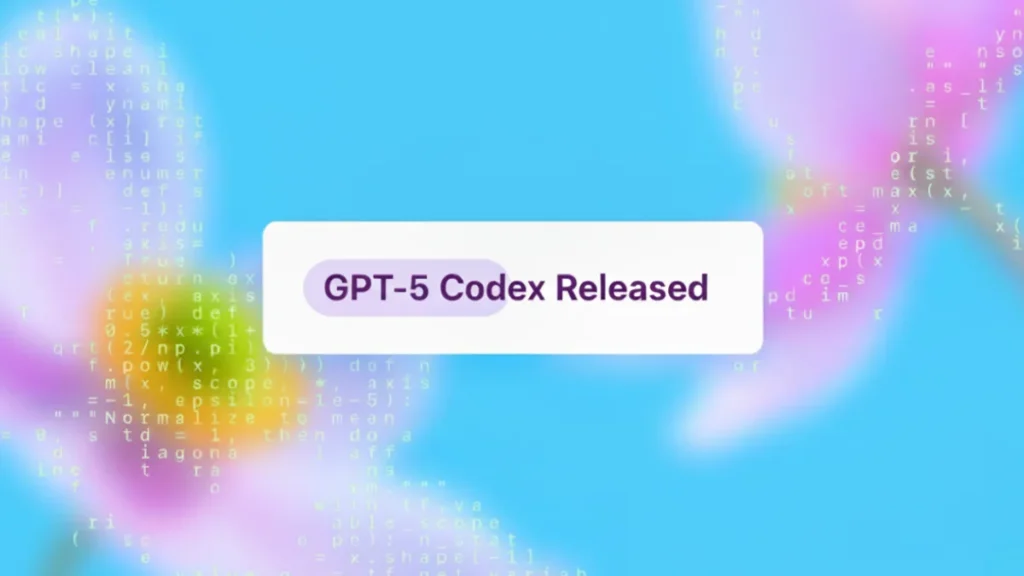OpenAI has released GPT-5 Codex, a purpose-built upgrade to GPT-5 designed for real-world software engineering.
The model takes a leap beyond interactive coding, handling multi-hour refactors, bug fixes, and even visual front-end tasks — signaling a major shift in how developers may soon work with AI teammates.
Key Takeaways
- GPT-5 Codex handles long refactors, bug fixes, and test creation autonomously.
- Integrated across CLI, IDE, cloud, GitHub, and mobile apps for seamless workflows.
- Code review quality improves — fewer irrelevant comments, more critical bug detection.
- Dynamic efficiency: fast on small requests, deep reasoning for complex projects.
- Visual context: accepts screenshots, outputs UI prototypes and testable builds.
GPT-5 Codex is OpenAI’s new AI model optimized for agentic coding. Unlike GPT-5, it balances quick interactive coding with long autonomous execution, performing code reviews, large-scale refactors, and UI prototyping. Integrated across CLI, IDE, cloud, and GitHub, it delivers faster, more accurate engineering support while requiring expert oversight.
A Next-Level Coding Teammate
OpenAI has officially launched GPT-5 Codex, a refined version of GPT-5 tuned for agentic coding. Unlike earlier iterations, which worked best in quick back-and-forth sessions, GPT-5 Codex can autonomously tackle long, complex engineering tasks, sometimes working for seven hours or more without intervention.
It’s already the default in Codex environments, available through CLI, IDE extensions, GitHub integration, web, and the ChatGPT iOS app. Subscribers across Plus, Pro, Business, Edu, and Enterprise tiers gain access automatically.
Why GPT-5 Codex Matters
Software engineering often requires large-scale consistency — propagating variables through hundreds of files, debugging intricate dependencies, or maintaining style across massive codebases. GPT-5 Codex is purpose-built for this kind of work.
In OpenAI’s internal benchmarks, the model achieved 51.3% accuracy on code refactoring tasks, compared with just 33.9% for GPT-5. On SWE-bench Verified, GPT-5 Codex completed all 500 engineering tasks, catching critical bugs during code reviews more effectively than GPT-5.
Inside the Numbers
The model dynamically adjusts its “thinking time” depending on task complexity. For short requests, it uses 93.7% fewer tokens than GPT-5, making it faster and cheaper. But for complex refactors, it spends over twice as long iterating, editing, and testing code before shipping results.
On code reviews, engineers rated Codex’s comments as more relevant and high-impact: only 4.4% of its comments were incorrect, compared with 13.7% for GPT-5, while 52.4% were judged “high impact”.
Expanded Tooling & Integrations
Developers now see Codex woven throughout the full workflow:
- CLI & Terminal: Codex CLI was rebuilt with to-do tracking, wireframe/screenshot sharing, and streamlined permission modes. The new terminal UI also formats diffs and tool calls for easier review.
- IDE Extensions: Works in VS Code, Cursor, and forks, tracking open files and code context seamlessly.
- Cloud Environment: Cached containers cut median task setup times by ~90%, with automatic dependency installs and runtime configurations.
- Visual Context: Developers can attach UI screenshots or bug captures; Codex inspects them, generates fixes, and even returns screenshots of its own work.
Use Cases Emerging
Real-world use cases are already becoming clear:
- Massive refactors across multiple languages, such as threading a new variable across thousands of lines.
- Feature development with tests, including automatic bug-fixing and test regeneration.
- Continuous code review, catching regressions and surfacing only high-priority issues.
- Front-end prototyping, where Codex turns wireframes or screenshots into functional UI.
Industry Response & Implications
For engineering teams, GPT-5 Codex could shift the workload balance. Repetitive or structurally heavy work — test scaffolding, style enforcement, dependency management — may now be delegated to AI, leaving developers free to focus on design and architecture.
But the shift also raises new questions. As AI takes on more of the reviewer role, human oversight must adapt from “spotting typos” to auditing an agent’s architectural decisions. Organizations will need policy and audit controls before rolling Codex into production-critical pipelines.
The Bigger Picture
GPT-5 Codex isn’t a replacement for engineers. Instead, it’s a force multiplier — increasing speed, improving code quality, and bridging cloud/local workflows. Still, OpenAI emphasizes safety: execution is sandboxed by default, with tiered approval modes to prevent overreach.
Conclusion
With GPT-5 Codex, OpenAI is pushing AI deeper into the day-to-day mechanics of software engineering. By blending autonomy, efficiency, and integration, it could reshape how teams code — but success depends on human oversight, safe deployment, and rethinking the role of engineers in an AI-driven workflow.
